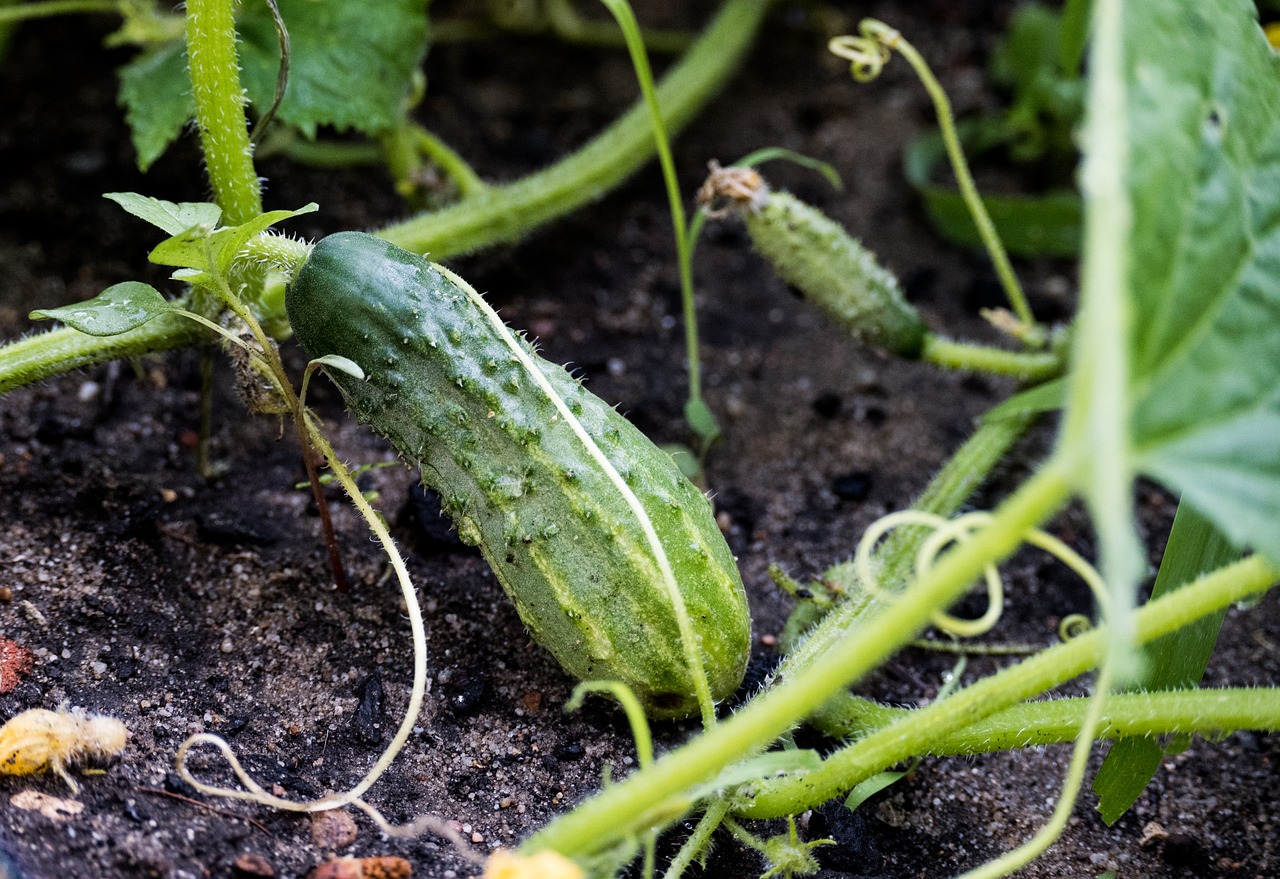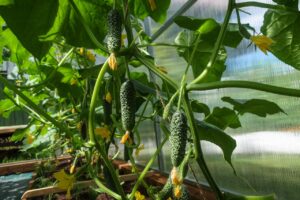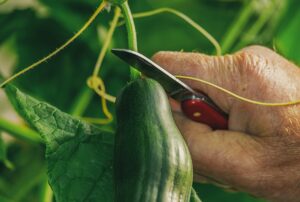The Ultimate Guide to Growing Bountiful Cucumbers
Cucumbers are a staple in my garden, and for a good reason! These versatile, nutritious vegetables are easy to grow and come in numerous cucumber varieties. In this comprehensive guide, we’ll cover everything you need to know about how to grow cucumbers, from planting seeds to harvesting, trellising, and cucumber plant care. Whether you’re a beginner or a seasoned gardener, this article will help you master the art of growing cucumbers.
Cucumber Varieties
Before diving into how to grow cucumbers, choosing the right cucumber varieties for your garden is essential. Here are some of my personal favourites and popular options:
- Straight Eight cucumbers: This beloved heirloom variety boasts a consistently straight shape, 8-inch length, and rich green skin, making it perfect for slicing and salads. Plus, they’re a breeze to grow.
- Lemon Cucumbers: Aptly named for their round, yellow appearance, they delight with a sweet, mild flavour that’s truly refreshing.
- English Cucumbers: With their elongated, slender form, they are ideal for slicing and offer the added benefit of fewer seeds than other varieties.
- Pickling Cucumbers: Tailor-made for pickling, these cucumbers are available in various sizes to suit your preserving needs.
- Armenian Cucumbers: Exhibiting a mild taste, these cucumbers are ideal for adding a subtle, refreshing crunch to your salads.
- Japanese Cucumbers: Boasting a thin skin and delightfully crispy texture, Japanese cucumbers are perfect for snacking and enhancing your salad creations.
Planting Your Cucumber Seeds
When you’re ready to plant your cucumber seeds, follow these steps:
- Prepare your soil: Cucumbers prefer well-draining, fertile soil with a pH between 6.0 and 6.8. Amend your soil with compost or well-rotted manure before planting.
- Choose the right time: Plant cucumber seeds after the last frost when soil temperatures reach at least 60°F (15°C). Cucumbers are sensitive to frost, so be cautious of cold temperatures.
- Sow the seeds: Sow cucumber seeds about 1 inch deep and 18-36 inches apart, depending on the variety. Adjust the spacing if you’re growing cucumbers vertically or in pots.
- Water consistently: Keep the soil consistently moist but not waterlogged. This will ensure successful germination and healthy growth.
Growing Cucumbers Vertically
Growing cucumbers vertically is an excellent option for gardeners with limited space or those looking to improve airflow around their plants. Vertical growth can also help reduce the disease risk and make it easier to harvest cucumbers. Here’s how to grow cucumbers vertically:
- Choose a suitable trellis: There are several types of trellises you can use for growing cucumbers, including A-frames, netting, and cages. Choose one that suits your space and preferences.
- Train your cucumbers: As your cucumber plants grow, guide them onto the trellis and gently secure them with soft ties or garden clips.
- Maintain the trellis: Regularly check your cucumber plants to ensure they continue growing up the trellis, and prune any dead leaves or stems.
Growing Cucumbers in Pots
Growing cucumbers in pots is another excellent option for those with limited space. Here’s how to grow cucumbers in pots:
- Select the right container: Choose a large pot with a minimum depth of 12 inches and good drainage. This will provide enough room for the cucumber plant’s root system to develop.
- Use quality potting mix: Fill your container with a high-quality, well-draining potting mix. Ensure it’s rich in organic matter to provide the necessary nutrients for your cucumbers.
- Choose a suitable variety: Opt for cucumber varieties that are well-suited for container gardening, such as bush or compact varieties. These types typically require less space and grow well in pots.
- Plant the seeds: Follow the same steps for planting cucumber seeds, as mentioned earlier, but adjust the spacing to suit your container size. Typically, one or two plants per pot are sufficient.
- Provide support: If you’re growing vining cucumber varieties in pots, consider adding a small trellis or stake for support.
Cucumber Plant Care
To ensure a successful cucumber harvest, it’s crucial to understand the specific care requirements for your plants. Here’s what you need to know:
- Watering frequency: Cucumbers require consistent moisture to thrive, so it’s important to know how often to water cucumbers. Water your plants deeply and consistently, providing 1-2 inches of water per week. It’s best to water in the morning to reduce the risk of disease caused by wet foliage.
- Sunlight requirements: Understanding how much sun cucumbers need is essential for their growth. Cucumbers require at least 6-8 hours of direct sunlight daily to produce a healthy crop.
- Fertilizing: Feed your cucumber plants with a balanced, slow-release fertilizer at the time of planting, and then apply a liquid fertilizer every 2-3 weeks during the growing season to ensure they receive the necessary nutrients.
Trellising Cucumbers
Trellising cucumbers saves space and improves airflow, reducing the risk of disease. Here’s how to trellis cucumbers effectively:
- Install a sturdy trellis: Before planting, install a trellis that can support the weight of your growing cucumbers. A sturdy structure will ensure your plants have adequate support throughout the growing season.
- Train your plants: Gently guide your cucumber vines onto the trellis, securing them with soft ties or garden clips. Check regularly to ensure the vines are growing up the trellis and not becoming entangled.
- Prune and maintain: Remove any dead leaves or stems to promote healthy growth and prevent disease.
Harvesting Cucumbers
Knowing when and how to harvest cucumbers is essential for enjoying fresh, crisp vegetables. Follow these tips for a successful cucumber harvest:
- Monitor size and colour: Harvest cucumbers when they reach their ideal size and colour, which varies depending on the variety. Pickling cucumbers should be harvested when they’re 3-5 inches long while slicing cucumbers should be picked at 6-8 inches long.
- Check for firmness: A ripe cucumber should be firm to the touch. If it feels soft, it may be overripe and should be harvested immediately.
- Use a clean, sharp tool: Use pruning shears or a sharp knife to harvest cucumbers, cutting the stem close to the fruit. This helps prevent damage to the plant and ensures a clean cut.
- Harvest frequently: Regular harvesting encourages the plant to produce more fruit. Check your plants every day or two during the peak growing season to ensure you don’t miss any ripe cucumbers.
By following the tips and advice in this comprehensive guide on how to grow cucumbers, you’ll be well on your way to enjoying a bountiful harvest of crisp, delicious cucumbers from your garden. From selecting the right cucumber varieties and planting seeds to providing proper care and harvesting, growing cucumbers can be a rewarding and enjoyable experience for gardeners of all skill levels.
Remember to provide your cucumber plants with consistent water, adequate sunlight, and the necessary nutrients for healthy growth. Additionally, consider growing your cucumbers vertically or in pots to maximize space and improve airflow around your plants. With proper care and attention, your cucumber plants will reward you with an abundance of fresh, tasty vegetables to enjoy in salads, pickles, and more.
Cucumber Companion Plants
Incorporating cucumber companion plants in your garden can provide numerous benefits, such as improved growth, better pest control, and increased pollination. You can create a thriving, harmonious garden ecosystem by choosing the right plants to grow alongside your cucumbers. Here are some of the best cucumber companion plants to consider:
Companion Plants
- Marigolds: These vibrant flowers add visual interest to your garden and help repel pests like aphids and beetles. Marigolds release a chemical that deters harmful insects, making them an excellent cucumber companion plant.
- Nasturtiums: Nasturtiums are another attractive flower that offers pest control benefits. These plants can help repel cucumber beetles and aphids, protecting your cucumber plants from potential damage.
- Beans: Beans and cucumbers make great companions, as beans can help fix nitrogen in the soil, providing essential nutrients for cucumbers. Additionally, beans may help deter pests like beetles and aphids.
- Radishes: Planting radishes near your cucumbers can help deter cucumber beetles, as the pungent scent of radishes is unappealing to these pests.
- Sunflowers: Sunflowers can support vining cucumber varieties, acting as a natural trellis. Additionally, sunflowers attract pollinators, promoting better fruit production for your cucumber plants.
- Peas: Like beans, peas can help enrich the soil by fixing nitrogen, which is beneficial for cucumber growth. Peas can also provide some shade for cucumbers during hot weather.
- Lettuce: Lettuce is another suitable cucumber companion plant, as it can help retain moisture in the soil and provide a living mulch. The shallow root systems of lettuce plants won’t compete with cucumber roots for nutrients.
When planning your garden, consider these cucumber companion plants to create a more productive, healthy, and attractive growing environment for your cucumbers.
Plants to Avoid
While some plants make excellent cucumber companions, others may negatively impact your cucumbers’ growth and health. It’s crucial to be aware of these incompatible plants when planning your garden layout. Here are some plants to avoid growing near cucumbers:
- Melons and Squash: Although cucumbers, melons, and squash are all members of the cucurbit family, it’s best to keep them separate. Growing them too close together can encourage the spread of pests and diseases that affect all three plants.
- Potatoes: Potatoes and cucumbers should be grown apart, as they can compete for nutrients and water. Additionally, potatoes may attract Colorado potato beetles, which can also feed on cucumber plants.
- Aromatic Herbs: Strong-smelling herbs such as sage, basil, and rosemary can negatively impact cucumber growth. These aromatic herbs may suppress cucumbers’ growth and alter their flavour.
- Tomatoes: Although tomatoes don’t directly harm cucumbers, they are prone to several diseases that can also affect cucumber plants, such as blight and mosaic virus. Growing these two plants apart is best to minimize the risk of disease transmission.
- Fennel: Fennel is known to inhibit the growth of many plants, including cucumbers. Its allelopathic compounds can suppress the growth of surrounding plants, making it an unsuitable neighbour for cucumbers.
Avoiding these incompatible plants can create a healthier growing environment for your cucumbers and ensure a more successful harvest. When planning your garden layout, keep these plants in mind and choose suitable companion plants that will promote the growth and health of your cucumbers.
Conclusion
Mastering how to plant and grow cucumbers in your garden is an enjoyable and rewarding experience. This comprehensive guide has provided you with valuable information on how to grow cucumbers, from planting cucumber seeds and choosing the right varieties to grow them vertically or in pots. We also covered essential techniques such as trellising cucumbers, understanding their care requirements, and harvesting. Additionally, we discussed the importance of cucumber companion plants and which plants to avoid for a thriving cucumber garden. With this knowledge, you’re now well-equipped to cultivate a bountiful harvest of delicious cucumbers. Happy gardening!







